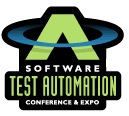Software Test Automation Fall 2001

PRESENTATIONS
|
Preparing for Test Automation-Are You Ready?
Test automation requires an investment in software testing tools, equipment, personnel, and time. There is also continuous maintenance required in keeping existing test scripts current as well as developing new ones. This presentation reviews some fundamental factors to consider before making these investments. |
|
|
Requirements-Driven Automated Testing
Studies have shown that over fifty percent of software defects are attributed to poorly defined requirements. From a process improvement perspective, it is imperative that project managers establish a more effective and efficient way of defining and tracking business requirements. Jeff Tatelman describes a "how to" approach for developing a practical automated regression testing process using a traceability matrix and business event scenarios. |
|
|
Scripts on My Tool Belt
The aims of this presentation are to: convince you that "test automation" is more than automating test execution; show some examples of the kinds of things that can be accomplished with scripting languages, using simplified code samples; and make you aware of three different scripting languages (shells, perl, and expect). |
|
|
Selecting Re-Tests for Corrected Defects Using Coverage Analysis Data
Topics covered in this presentation include: Why and when to trim the test suite; How to select tests to run with |
|
|
Software Test Automation Fall 2001: Data-Driven Automated Testing Using XML
Test automation is an unavoidable entity for testing Web-based applications where reduced time-to-market is the name of the game. Data-driven test cases allow the test automation engineer to automate/develop once and run many times with different conditions to test the system. Learn why XML-the markup language for documents containing structured information-is the best way to present the test data for automated testing. Explore the advantages and disadvantages of XML-based test data. |
|
|
Software Test Automation Fall 2001: Test Automation with Action Words: A Practical Experience
Action Word Testing. This concept illuminates testing as an action, a process, an art. Learn how Action Word Testing can be applied to deal with critical test issues such as lack of functional knowledge of a system under test; instability of the design during test development; and automation of 100% of the functional or technical tets. Hans Buwalda uses a financial exchange that's introduced a new electronic trading system to demonstrate Action Word Testing (approximately 15,000 tests). |
Hans Buwalda, LogiGear Corporation |
|
Test Automation Management
Automating the execution of tests is becoming more and more popular as the need to improve software quality amidst increasing system complexity becomes ever stronger. The appeal of having the computer run the tests in a fraction of the time it takes to perform them manually has |

Mark Fewster, Grove Consultants |
|
Test Automation-State-of-the-Practice
The current state of software test automation is in flux. Today's technologies-the Web, Java, wireless technologies, etc.-have changed how we do business and how we need to test. Test automation technologies are changing to keep up. Edward Kit summarizes the key shifts in the automated software quality industry and presents a new automation model, including an integrated set of testing processes and techniques. |
|
|
The Importance Load Testing Plays in the Internet Economy
This presentation suggests reducing performance problems with these Key Steps: 1) plan for performance testing; 2) use baselining and consistent metrics; 3) build realism into tests to gain accuracy; 4) leverage performance testing assets; 5) make performance testing an ongoing effort; 6) investigate new options in load testing. |
|
|
The New Economics of Test Automation
The New Economy is changing the dynamics of the market and the economics of test automation. There has never been a better time to invest the time and money to deploy the processes and tools necessary to achieve successful automation. In this keynote presentation, Linda Hayes discusses ways to reposition your test organization from a technical cost center to a business investment opportunity to gain the attention and commitment of senior management. Find out how to get more time and money, and what to deliver instead of bug reports. |

Linda Hayes, WorkSoft |


